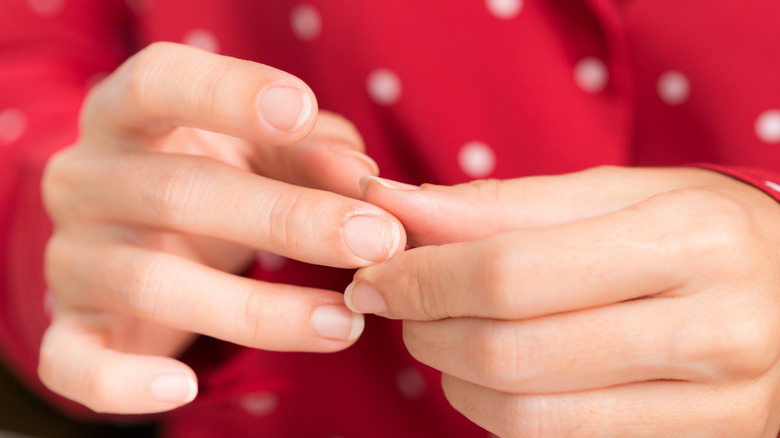What Causes Fingernails To Split Down The Middle
If you've ever nervously picked at your nails a little too deeply, you know the discomfort that results from hitting on those sensitive nerve endings. While we may experience the occasional snag or crack off the top of the nail, such as when clipping them, we don't often think about our nails splitting right down the middle like a crack from an earthquake. So why might this happen?
If you're someone who tends to pick at or bite down on their fingernails, this can cause gradual damage. As the nail weakens, it may eventually split. Similarly, physical trauma can also result in a split nail, particularly if the nail bed is injured. Alternatively, while moisture is key in keeping many parts of our body healthy — like our hair, eyes, or skin — too much moisture can actually make our nails more frail. Therefore, leaving our nails soaking in water for long stretches of time can increase the risk of splitting and breakage.
Health conditions related to split nails
In some cases, a nail that splits directly down the middle may indicate a potential health condition. This can include fungal infections, otherwise referred to as onychomycosis (via Ada Health). Although more commonly contracted on the toenails, fingernail fungal infections are still possible. As the nail breaks down, crumbling and flaking is common, leading to possible splitting and breakage of the nail.
Split nails may also be tied to other medical conditions such as stomach cancer, lupus, heart disease, liver disease, and more, according to Healthline. Experts at Tuggeranong Square Medical Practice add that this can also include hypothyroidism. Our thyroid is tasked with regulating our hormones and metabolism, but a lack of thyroid hormone can impact the health of our nails. The same is true when it comes to certain nutrition deficiencies, such as a deficiency in protein, folic acid, or vitamin C.
Reduce your chances for split fingernails
Although rare, a vertical splitting of the nail down the middle can also be characteristic of median canaliform dystrophy, according to 2012 research published in the Indian Dermatology Online Journal. In one case study involving a student in their mid-20s, the individual presented with additional angled ridges alongside the vertical split on each one of her thumbnails, giving it the appearance of fir tree branches.
Certain factors are thought to increase one's risk for the condition, such as a family history of nail disorders, allergen exposure, and pushing back one's cuticles. However, there is also some evidence to suggest that the use of oral retinoid medications may be linked with the condition. Generally speaking, median canaliform dystrophy often resolves on its own over time.
To help keep split nails at bay, try to refrain from any picking or biting. Wearing protective gloves while cleaning or working with chemicals can also help keep your nails protected. Additionally, avoid prolonged exposure to water. Remember, too much water can negatively affect our nails, so stick to moisturizer instead.



